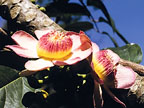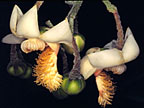

 |
 |
Report corrections to Scott A. Mori (smori@nybg.org)
Jean Baptiste Christophe Fusée Aublet (1720-1778) spent the early part of his adult life studying Natural History and Chemistry. One of his mentors was Bernard de Jussieu who later helped him to identify and write up the collections that served as the basis for his Histoires des Plantes. In 1751, Aublet was appointed as the Botanist and principal Apothecary of the Ile-de-France (now known as Mauritius) for the Compagnie des Indes. His mission was to establish a laboratory that would produce medicine for the colony and to start a botanical garden of useful plants. In the Histoire des Plantes, he includes a report of his stay in Mauritius which provides a list of the plants he observed on Mauritius.
After many difficulties in Mauritius, Aublet returned to France in 1762 and eventually accepted a position as Apothecary Botanist in French Guiana by invitation of the King of France. He departed for his new post on 30 May 1762 and arrived at the Isle de Cayenne the 23rd of August. During his two years in French Guiana, he dedicated every free moment that he had to observing and collecting plants ("Tous les momens que me laissoient mes devoirs étoient consacrés à la recherche des plantes, & à les décrire avec tout le soin possible sur le lieu mème, ..."). Aublet's health began to decline toward the end of his stay in French Guiana.
Aublet departed French Guiana for Saint-Domingue (Haiti) in 1764 by invitation of the Comte d'Estaing. There he supervised the construction of a number of buildings that he enumerates in his Histoire. However, the poor health that plagued him during the latter months of his stay in French Guiana followed him to Haiti and forced him to return to Paris in 1765 where he continued to have health problems.
In spite of his poor physical condition, he was able to write his Histoire des Plantes, a book that serves as a starting point for the study of the flora of French Guiana. In the same year Plantae Surinamensis was published by Linnaeus (1775) which, together with the Histoire, is a reference that most Neotropical botanists need to consult at some time in their careers. In addition, the Histoire includes essays on economically important plants, such as manihot and sugar cane, and about the people of the colony. Aublet, according to Plotkin et al. (1991), was probably the "founding father" of ethnobotany in the Neotropics.
Among the plants Aublet described as useful are several species of Lecythidaceae. He reports that the bark of Couratari guianensis is cut into wide strips which are tied together at the ends and used as a loop around the feet to aid in climbing into trees. In the description of Lecythis grandiflora (now Eschweilera grandiflora) Aublet reports that its local name is “marmite de singe” (monkey’s lunch bucket) because the seeds are very good to eat and come in pot-like fruit. This name does not apply to Lecythis grandiflora but instead refers to Lecythis zabucajo, a species that does indeed have delicious seeds that rival the Brazil nut in flavor. The seeds of L. grandiflora are not known to be edible. Caution has to be used in eating seeds of Lecythidaceae because some of them are bitter and inedible and may even be poisonous. There is another problem with the treatment of Lecythis grandiflora in that the description and Plate 285 detail the fruits of Lecythis zabucajo, which are the largest of any Lecythidaceae native to the Guianas and can not be mistaken for L. grandiflora. Thus, although Plate 283 and 284 accurately depict the inflorescence and flowers of L. grandiiflora, the description of the fruits and Plate 285 refer to L. zabucajo. As a result, Aublet’s description of L. grandiflora is a mixture of two species and supports Howard’s (1983) conclusion that a number of species in the Histoire are composites of discordant elements.
Another problem is in the description of Pirigara tetrapetala (= Gustavia tetrapetala) because Aublet describes and illustrates the petals as four. In spite of extensive collections made in the areas that he explored, a species of Gustavia with four petals has never been made. Others and myself have placed this name in synonymy under G. augusta.
Aublet’s herbarium, drawings, and notes were purchased by Sir Joseph Banks and are now archived at the British Museum of Natural History. Some collections were apparently shared with Linnaeus filius and those are in the J.E. Smith Herbarium of the Linnaean Society. Significant numbers of Aublet collections are found in herbaria in Paris, Stockholm, Copenhagen, and Vienna. while fewer are at Brussels, the Field Museum in Chicago, Liverpool, Missouri, and Uppsala (Howard, 1983). Aublet collections are also found in the Tristan Herbarium in Orléans, France (Souilijaert & Stafleu, 1953) and an important series of Aublet collections that originally made up part of J. J. Rousseau’s herbarium was discovered in France by Lanjouw & Uittien (1940).
Throughout Aublet’s career he was plagued by bad relationships with others. For example, Pierre Poivre introduced five plants into Mauritius of what he said were nutmeg (Myristicafragrans), but these were proclaimed to be false nutmegs by Aublet and this created animosity between him and Poivret. He was also accused of boasting that he had sired 200 or more children; and that he often stayed comfortably in villages while Amerindians and slaves gathered his botanical collections (Bernardi, 1976). In the Histoire, Aublet spends considerable time developing arguments to show that the calumnies against him were not true. Moreover, Aublet’s ability to accomplish tasks assigned to him is evidenced by the fact that he was able to secure new positions after departing from both Mauritius and French Guiana.
Aublet treated 576 genera of which 208 were described as new to science. Most of his genera were monotypic at the time he described them. Many of the epithets came from the names used by Amerindians or Creoles. Because of that, subsequent authors of that period considered them to be barbaric and often replaced them with other names. The fate of all of Aublet’s generic names has been discussed by Zarucchi (1984) who points out that the families Cabombaceae, Goupiaceae, Humiriaceae, Mayacaceae, Quiinaceae, Rapateaceae, Simaroubaceae, Trigoniaceae, and Vochysiaceae are based on Aublet’s genera.
Literature Cited
Aublet, F. 1775. Histoire des plantes de la Guiane Françoise. Préface: tome I: i-xxviij.
Bernardi, L. 1976. J.-B. Fusée-Aublet, le brave botaniste de onzième heure. Musée de Genève 169: 2-10.
Howard, R. A. 1983. The plates of Aublet’ Histoire de Plantes de la Guiane Françoise. J. Arnold Arbor. 64: 255-292.
Linnaeus. C. 1775. Plantae Surinamensis 17. Uppsala
Plotkin, M. J., B. M. Boom & M. Allison. 1991. The ethnobotany of Aublet's Histoire des Plantes de la Guiane Françoise (1775). Monogr. Syst. Bot Missouri Bot. Gard. 35: 1-108.
Zarucchi, J. L. 1984. The treatment of Aublet’s generic names by his contemporaries and by present-day taxonomists. J. Arnold Arbor. 65: 215-242.
Acknolwedgements
I am grateful to the LuEsther T. Mertz Library of The New York Botanical Garden for giving me permission to duplicate this information and to Sandra McNeill for executing the scans and my wife, Carol Gracie, for editing the scans. I thank the Botanical Research Institute of Texas (BRIT) for the financial support that enabled me to make this information about Lecythidaceae available online. Support from BRIT comes from the Andes to Amazon Botany Program (AABP) which, in turn, is supported by a grant from the Gordon Moore Foundation. I am thankful to John Janovec (Director of the AABP) and Sy Sohmer (Director of BRIT) for their committment to taxonomic botany and their willingness to provide funds to advance knowledge of tropical botany. John Janovec has been the driving force behind my desire to make information about Lecythidaceae available online, and I am grateful to him for inspiration and support. Finally, I thank The New York Botanical Garden for making my studies of Lecythidaceae possible.